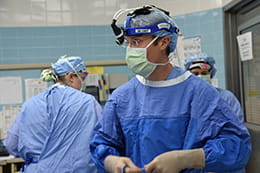Indiana University School of Medicine Department of Urology faculty experts provide clinical care for patients with testicular cancer from all over the world through the university’s partnership with Indiana University Health. Their research has led to groundbreaking new ways to diagnose and treat testicular cancer.
Symptoms
Symptoms of testicular cancer include a painless, firm, enlarged mass in the testicle. Patients may also have a feeling of heaviness in the scrotum, a dull ache in the groin, and testicular and back pain.
Evaluation
A testicular mass warrants a prompt and thorough investigation. The three main components of proper initial evaluation include a careful physical examination with focus on the scrotum, testicular ultrasound and blood tests to evaluate tumor markers specific for testicular cancer (i.e. beta human chorionic gonadotropin and alpha-fetoprotein).
Ultrasound examination can provide important details of tumor characteristics and document the shape and location of the lesion. This test uses soundwaves to create an image of the scrotum and testicles. During this exam, patients lie down on their backs and a clear gel is applied to the scrotum. A hand-held ultrasound probe is moved over the scrotum to create the images.
Obtaining serum tumor marker values, including α-fetoprotein, human chorionic gonadotropin and lactate dehydrogenase aids in solidifying a diagnosis of a germ cell tumor and serves as a baseline to compare serologic trends after orchiectomy. While there can be rare elevations of these blood tests, most often they are elevated in association with testicular cancer.
Diagnosis
If the physical exam, testicular ultrasound, and tumor marker assessment is concerning for testicular malignancy, a radical orchiectomy is the diagnostic and therapeutic treatment of choice. This is when the surgeon will make an incision in the inguinal region on the affected side and remove the testicle. The testicle will be sent for pathological evaluation to determine the type of testicular cancer (e.g. seminoma, nonseminoma). Once the diagnosis of testicular cancer has been confirmed, then additional staging information will be required to properly assess the stage and disease risk. This is completed through computed tomography imaging of the chest, abdomen and pelvis.



